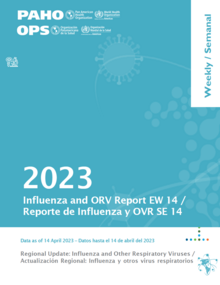North America: Influenza virus activity decreased overall, with the predominance of influenza B viruses. All seasonal influenza subtypes were detected. SARS-CoV-2 circulated at moderate levels, and RSV activity was very low. Influenza activity was low in Canada and the United States. Influenza activity recently increased in Mexico, at low-intensity levels, with elevated SARS-CoV-2 and RSV activity, but decreasing.
Caribbean: Influenza percent positivity increased, driven mainly by influenza B/Victoria lineage viruses. In addition, the influenza A(H1N1)pdm09 virus co-circulated. In Belize and Jamaica, influenza activity was increased, with influenza B/Victoria lineage circulation. In addition, SARI cases were raised in Jamaica, mainly in children under five. Overall, SARS-CoV-2 and RSV activity were low in the subregion.
Central America: Influenza percent positivity increased, with influenza A(H1N1)pdm09 virus predominance and co-circulation of influenza A(H3N2) and B/Victoria. Influenza activity was moderate in Guatemala with influenza A(H3N2) and B/Victoria viruses co-circulation. Honduras and Panama reported low-intensity levels of influenza B (lineage undetermined). SARS-CoV-2 percent positivity dropped in the subregion, except in Costa Rica and Panama. In Guatemala, RSV activity increased, remaining low in other countries.
Andean: Influenza activity was low, predominating influenza A(H1N1)pdm09 viruses; influenza B/Victoria and A(H3N2) viruses co-circulated. Venezuela reported increased influenza activity, with A(H1N1)pdm09 circulation. SARI cases / 100 hospitalizations were at moderate levels, with 12% positive for influenza in Bolivia. In the subregion, SARS-CoV-2 was low, with increasing activity in Ecuador and Peru. RSV activity was low, but an increasing trend was observed in Bolivia and Colombia.
Brazil and Southern Cone: Influenza activity was low but increasing, with influenza B viruses more frequently detected and all seasonal influenza subtypes detected. Chile and Paraguay reported increasing influenza activity, with SARI cases at low levels primarily associated with SARS-CoV-2 and RSV viruses. Increased SARS-CoV-2 activity was reported in Brazil, Chile, and Paraguay. RSV activity was low in the subregion.
Global: Influenza detections decreased steeply in January after a peak in late 2022. Detections in 2022 were predominantly influenza A(H3N2). After the end of January 2023, activity increased again with a higher proportion of influenza A(H1N1)pdm09 and B virus detections until a peak around week 10, after which detections decreased. In Europe, overall influenza detections decreased, and influenza positivity from sentinel sites decreased to 16% but remained above the epidemic threshold at the regional level. Of 41 countries, 13 reported moderate intensity, with the remainder reporting low or below baseline intensity. Out of 40 countries, 20 continued to report widespread activity. Overall, influenza B viruses predominated in both sentinel and non-sentinel surveillance, as all subregions experienced a wave of influenza B activity after an initial influenza A wave. Of the few influenza A viruses detected, most were influenza A(H1N1)pdm09. Influenza detections decreased or were stable in most countries except Lithuania and Norway, where slight increases were reported. In Central Asia, sporadic influenza detections were reported in Kazakhstan (influenza A(H1N1)pdm09) and Tajikistan. In Northern Africa, influenza detections were very low. In Western Asia, influenza activity decreased but continued to be reported in some countries with detections of all seasonal influenza subtypes. In East Asia, influenza activity continued to be driven predominantly by A(H1N1)pdm09 detections in China, which appeared to reach a peak and decrease slightly. Slight increases in some indicators of influenza activity were reported in China, the Hong Kong Special Administrative Region (SAR), China, and the Republic of Korea. In tropical Africa, influenza activity increased in some countries of Western Africa, while detections were low across reporting countries in Middle and Eastern Africa. In Southern Asia, influenza activity remained low, with influenza A(H3N2) and B/Victoria lineage viruses predominating. In South-East Asia, influenza activity remained elevated mainly due to influenza B detections in Malaysia and influenza A(H3N2) in Singapore. In the temperate zones of the southern hemisphere, influenza activity remained low; however, influenza activity increased slightly in Australia. RSV activity was generally low or decreasing globally except in Australia, New Zealand, and South Africa.
SARS-CoV-2 positivity from sentinel surveillance decreased from around 20% to 12% globally. Activity decreased slightly to about 20% in the Americas but increased to just below 20% in the Eastern Mediterranean Region. Activity remained around or below 10% in the other regions. SARS-CoV-2 positivity from non-sentinel surveillance was reported at around 23% globally.
Avian Influenza: A summary of the avian influenza situation in the region, case management and recommendations are available at Epidemiological alerts and updates | PAHO/WHO | Pan American Health Organization (paho.org)
|

